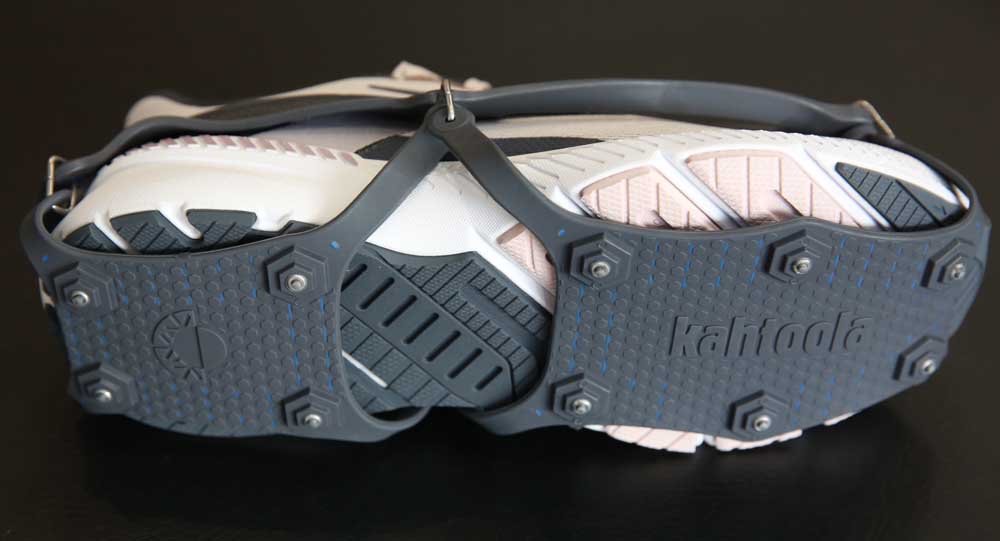Central Oregon runners have plenty of options for traction, and trails, during the winter
Published 4:00 am Friday, February 12, 2021

- Kahtoola NANOspikes can be seen on a shoe at FootZone.
Running is a year‑round sport in Central Oregon.
Sure, some runners prefer a treadmill or an elliptical to dealing with challenging outdoor conditions, but winter can be an exhilarating time to be out logging miles on roads or trails across the High Desert.
Trending
“There’s a lot of people who just will not run in the winter, or they run on the treadmill,” said Max King, a professional runner and longtime Bend resident. “I think it’s beautiful. I think it’s nice running in the winter. The best is that inch or two of fresh snow with no tracks in it if you get out early. The snow just packs and sticks.”
The problems for runners arise when that snow gets packed down or freezes and thaws and turns into ice. The current snowstorm blanketing Central Oregon means runners might need traction devices over the next few days or weeks, as they did when snow covered the region last month.
Runners who refuse to succumb to the indoor monotony of a treadmill have plenty of options for traction. Within the Central Oregon running community, “screwing your shoes” seems to be the most popular.
The process includes drilling eight to 10 screws into the sole of an older but still usable pair of running shoes. It works with regular, quarter-inch sheet metal screws or with carbide steel screws.
“I think that’s the best way to go, honestly,” said March Stockamp, an avid runner and marketing manager at the FootZone running store in Bend. “It’s the most cost effective, and it offers the best traction, as well. The main downside is not everyone has two pairs of running shoes. You need a second pair because then you can leave them in one pair of shoes for an entire winter.”
FootZone offers sets of carbide steel screws for $10, and the store provides installation, as well.
Trending
Runners in Central Oregon like the screws because they seem to work better in variable conditions, including snow, ice and bare pavement, which can all be encountered on the same run. Traction devices that are strapped onto the bottom of shoes, such as Yaktrax and Kahtoola, work great in fresh or packed snow, but can be cumbersome on bare pavement and could slide on ice.
“Bend is super patchy with snow and ice,” Stockamp said. “With screws, you don’t have to worry as much about where you’re placing your foot. With Yaktrax, you’re more trying to stay on the snow and ice.”
Yaktrax (which cost about $30 to $40) employ a coil traction system. The Yaktrax Run include carbide steel studs that dig into the snow and ice.
“They have the most name recognition,” Stockamp said of Yaktrax. “Personally, I don’t think they offer the most traction. One of the complaints is on sheer ice surfaces, the coils tend to slide. If you have them on, you want the ice and snow because on the bare pavement, they don’t work great. But a lot of people like them.”
King said the screws work better because they are lower profile, making them more manageable on bare pavement.
“And you can take them out in the spring,” King said. “It doesn’t do much to the shoe or reduce the durability. It just puts a little hole on the bottom.”
Kahtoola NANOspikes traction devices (which cost about $50 to $60) are similar to Yaktrax but do not use coils. Instead, they use only carbide spikes.
“They offer better traction, in my opinion, and feel more natural when you hit a dry surface,” Stockamp said of Kahtoola. “They don’t slide or slip on dry surfaces. They’re also a little more durable, but a little more expensive.”
Because snow- and ice-covered trails in Central Oregon can become lumpy and uneven during the winter, Stockamp does more road running than trail running this time of year. Plowed roads and sidewalks tend to offer a more steady and stable running surface.
“Right after it snows, I just hit the roads in my trail shoes,” Stockamp said. “As it becomes more packed, I switch to my screwed shoes. When you hit dry patches, it clicks a little, but it feels fine.”
Runners can often venture east or north of Bend to find snow-free trails during the winter. King said he likes to run trails at Smith Rock State Park and Gray Butte near Terrebonne, and he also enjoys trails near Lake Billy Chinook, including the Otter Bench and Tam-a-lau trails.
Stockamp prefers the Oregon Badlands Wilderness east of Bend, an open, flat expanse of juniper trees and lava rocks that tends to melt more quickly than other areas near Bend. Horse Butte and Horse Ridge, both southeast of Bend, are other popular wintertime trail-running destinations on the High Desert.
Some locations, though, would be best to avoid until spring.
“One area I would avoid is Shevlin Park,” Stockamp said. “It’s just an ice bowl in there. I’ve seen so many people at FootZone who have hurt themselves falling at Shevlin Park. It’s a beautiful area in the winter, but it’s not worth it to me to deal with all the ice there.”
Still, Central Oregon runners have myriad options for trails and traction to get them through the winter.








